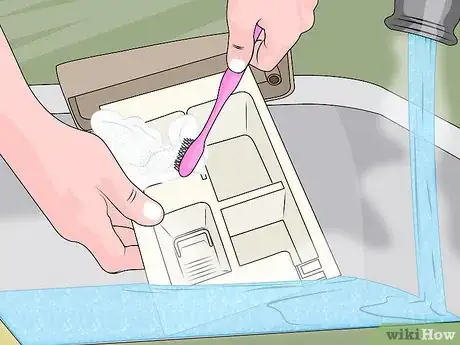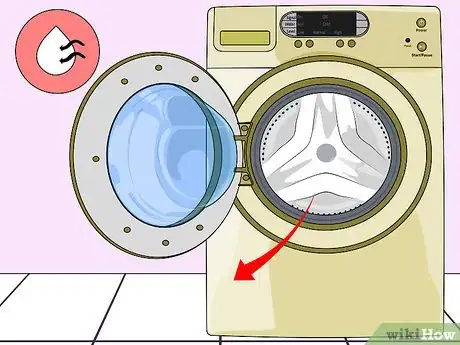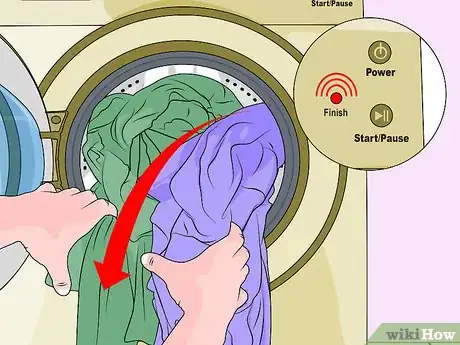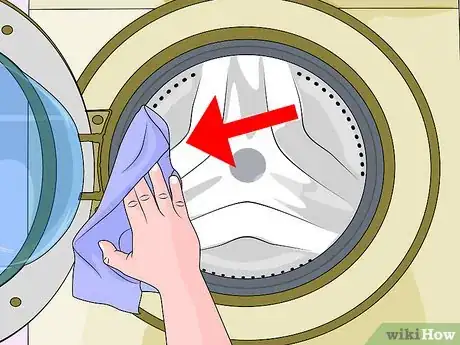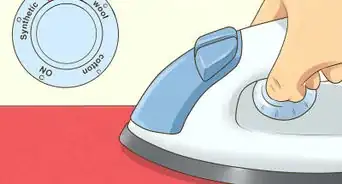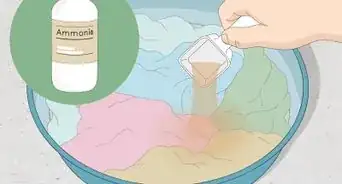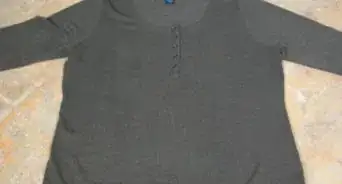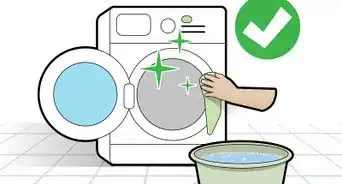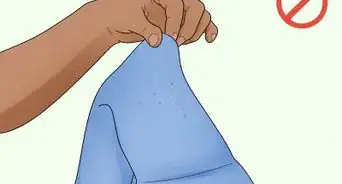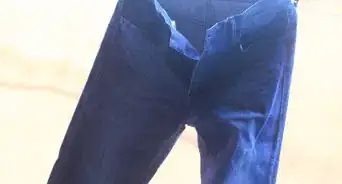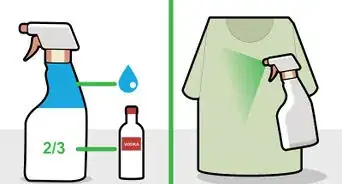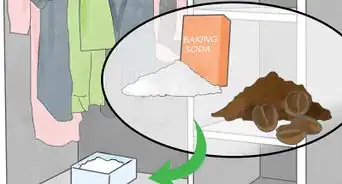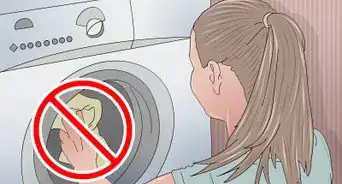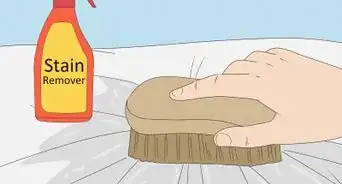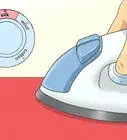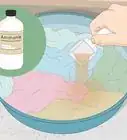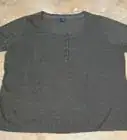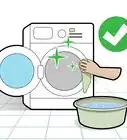This article was co-authored by Ashley Matuska. Ashley Matuska is a Professional Cleaner at the Founder and Owner of Dashing Maids in Denver, Colorado. Ashley has over seven years of experience in the cleaning industry. She and her team specialize in offering sustainable deep cleaning and maintenance cleaning services.
wikiHow marks an article as reader-approved once it receives enough positive feedback. This article has 20 testimonials from our readers, earning it our reader-approved status.
This article has been viewed 1,372,006 times.
If you have a front loader washing machine, you may notice a moldy smell spoiling all your towels and clothes. This is because front loading washers have multiple parts that can remain wet after a washing cycle. There are multiple products you can use to clean your washing machine, but its best to wipe the parts down as well. There are also lots of tips you can use to prevent mold smell from accumulating in your machine.
Steps
Part I: Cleaning The Washing Machine
-
1Clean the gasket. This is the rubber strip on the door and inside that provides a tight seal when the door shuts.[1] [2]
- Use a rag or towel to wipe the gasket down.
- You can use hot soapy water or a small spray of mildew cleaner. If you use mildew cleaner, be careful with these chemicals as they can irritate skin.
- You can also use a mixture of 50% water and 50% bleach on a rag. [3]
- Make sure to wipe around it and underneath it.
- You might find a lot of debris and slimy residue around the gasket. This is one of the most common sources of mold smell in front loading washing machine.
- If the residue under the gasket is persistent and hard to remove with a rag, try using an old toothbrush to scrub it out of hard to reach nooks. [4]
- If you come across any stray socks or clothing articles, be sure to remove them.
-
2Clean the soap dispensers. These might be able to be removed from your washing machine to make this easier.[5]
- Soap residue and small amounts of old stagnant water can make your dispensers smell.[6]
- Remove the dispensers and give them a thorough cleaning with hot soapy water.
- If you can't remove them, you can wipe them out with soapy water.
- Use a spray bottle or pipe cleaner to get into the nooks and crannies of the dispenser.
Advertisement -
3Run a cleaning cycle on your machine. Use the longest wash with the hottest water setting available. [7]
- Some washing machines have a tub cleaning cycle.
- Pour one of the following directly into the tub of the washing machine: 1 cup bleach, 1 cup of baking soda, 1/2 cup of enzymatic dishwasher detergent, or a commercial washer cleaner.
- Some common brands of washer cleaner are Affresh or Smelly Washer.
- Tide also makes a washer cleaner that you can buy in the laundry aisle of your supermarket.
- Run your cycle completely. If the smell remains, try another cycle.
- If after running the cycle twice the smell persists, try another additive. For example if you used baking soda the first round, try washer cleaner or bleach on the second try.
-
4Call a repair place. Your washer may be under warranty for an issue like this. Check your user manual. [8]
- If your smell persists you might have a clogged drain or filter. There might also be mold growing behind the washing machine drum.
- A qualified repair person will be able to diagnose any further problems and recommend solutions.
- If you are familiar with washers, you can try to clean the drain and filter yourself. You can find this usually in the small door at the base of the front of the washer.
- Be sure to have a bucket handy to collect any stagnant water.
Part II: Preventing Smells in Your Front Loading Washing Machine
-
1Use the right detergent. Most High Efficiency (HE) machines require HE detergent. [9]
- Using non-HE detergent will cause too many suds to form.[10] These suds will leave behind a residue that can start to smell.
- Don't use too much detergent either. This will also cause residue to form inside your washing machine.
- Powdered detergent often is a better alternative to liquid as it tends to produce fewer suds. [11]
-
2Avoid liquid fabric softener. Use dryer sheets instead.
- Much like liquid detergent, liquid fabric softener can also cause residue to build up inside your machine.
- This residue will develop a bad odor over time.
- Buy dryer sheets instead. These are inexpensive and can be found in the laundry aisle of any supermarket.
-
3Air out the washing machine between loads. This will decrease the mold build-up as it allows the tub to dry completely.[12]
- Leave the door slightly ajar when the machine is not in use.[13]
- This will allow fresh air to circulate through the drum of the front loading washing machine and will help dry any remaining moisture after a load.
- If you have small children or pets, you should avoid doing this as they can climb into the drum and become accidentally trapped inside.[14]
-
4Remove wet clothes immediately. Right after a cycle ends, take the wet clothes out.[15] [16]
- Set your washer to beep when a cycle is complete, so you don't forget to take the clothes out.
- If you can't dry your clothes right away, take them out and put them in a hamper or lay them flat until the dryer is available.
- This will prevent excess moisture from building up inside the washing machine drum after each load.
-
5Wipe down the gasket regularly. Do this is a dry towel.[17] [18]
- Ideally, the gasket, the area underneath it and the inside of the drum should be wiped dry after each cycle.
- This can be time consuming and a nuisance, so be sure to do this periodically at the very least.
- You can also wipe down the gaskets with hot soapy water regularly and allow them to completely dry. This will keep them clean and free of mildew.
-
6Clean your washing machine once a month. Use a hot water or cleaning cycle. [19]
- Pour two cups of white vinegar into the detergent dispenser and run a hot water or cleaning cycle.
- You can also use a commercial washing machine cleaner such as Smelly Washer, but vinegar is more cost effective and just as efficient.
- When finished, clean the inside of the tub, gasket, detergent dispenser and inside of the door with a mixture of hot water and vinegar and a towel.
- Repeat wiping down the inside parts of the washer with hot water only.
- Run your washer again with hot water only.
- Leave your washer door open to let the inside of the unit dry.
Expert Q&A
-
QuestionDo I need to clean my self-cleaning washer?
 Ashley MatuskaAshley Matuska is a Professional Cleaner at the Founder and Owner of Dashing Maids in Denver, Colorado. Ashley has over seven years of experience in the cleaning industry. She and her team specialize in offering sustainable deep cleaning and maintenance cleaning services.
Ashley MatuskaAshley Matuska is a Professional Cleaner at the Founder and Owner of Dashing Maids in Denver, Colorado. Ashley has over seven years of experience in the cleaning industry. She and her team specialize in offering sustainable deep cleaning and maintenance cleaning services.
Professional Cleaner Yes—the washer cleans mud, soil, and dirt from your clothes. These tend to accumulate in your washing machine, which can lead to bacteria and mold growth. Also, moisture from the washer can lead to mold and mildew.
Yes—the washer cleans mud, soil, and dirt from your clothes. These tend to accumulate in your washing machine, which can lead to bacteria and mold growth. Also, moisture from the washer can lead to mold and mildew. -
QuestionHow do I keep mold from growing in my front-load washer?
 Ashley MatuskaAshley Matuska is a Professional Cleaner at the Founder and Owner of Dashing Maids in Denver, Colorado. Ashley has over seven years of experience in the cleaning industry. She and her team specialize in offering sustainable deep cleaning and maintenance cleaning services.
Ashley MatuskaAshley Matuska is a Professional Cleaner at the Founder and Owner of Dashing Maids in Denver, Colorado. Ashley has over seven years of experience in the cleaning industry. She and her team specialize in offering sustainable deep cleaning and maintenance cleaning services.
Professional Cleaner Regularly wipe the mold and mildew from the rubber gasket on the washer. Also, don't leave wet clothes in the washer once they're finished washing, avoid using high-suds detergent, and leave the door of the washing machine open when you're not using it.
Regularly wipe the mold and mildew from the rubber gasket on the washer. Also, don't leave wet clothes in the washer once they're finished washing, avoid using high-suds detergent, and leave the door of the washing machine open when you're not using it. -
QuestionIs there a difference between baking powder and bicarbonate soda?
 Community AnswerBaking powder contains baking soda, but also contains cream of tartar, and sometimes cornstarch.
Community AnswerBaking powder contains baking soda, but also contains cream of tartar, and sometimes cornstarch.
References
- ↑ Ashley Matuska. Professional Cleaner.
- ↑ http://www.todayshomeowner.com/how-to-remove-mold-and-mildew-from-front-load-washing-machines/
- ↑ http://www.cleanandscentsible.com/2013/09/how-to-clean-your-washing-machine.html
- ↑ http://www.cleanandscentsible.com/2013/09/how-to-clean-your-washing-machine.html
- ↑ http://www.todayshomeowner.com/how-to-remove-mold-and-mildew-from-front-load-washing-machines/
- ↑ Ashley Matuska. Professional Cleaner.
- ↑ http://www.todayshomeowner.com/how-to-remove-mold-and-mildew-from-front-load-washing-machines/
- ↑ http://www.todayshomeowner.com/how-to-remove-mold-and-mildew-from-front-load-washing-machines/
- ↑ http://www.angieslist.com/articles/how-remove-mildew-odor-your-front-load-washer.htm
- ↑ Ashley Matuska. Professional Cleaner.
- ↑ http://www.todayshomeowner.com/how-to-remove-mold-and-mildew-from-front-load-washing-machines/
- ↑ http://www.cleanandscentsible.com/2013/09/how-to-clean-your-washing-machine.html
- ↑ Ashley Matuska. Professional Cleaner.
- ↑ http://www.todayshomeowner.com/how-to-remove-mold-and-mildew-from-front-load-washing-machines/
- ↑ Ashley Matuska. Professional Cleaner.
- ↑ http://www.todayshomeowner.com/how-to-remove-mold-and-mildew-from-front-load-washing-machines/
- ↑ Ashley Matuska. Professional Cleaner.
- ↑ http://www.todayshomeowner.com/how-to-remove-mold-and-mildew-from-front-load-washing-machines/
- ↑ http://www.angieslist.com/articles/how-remove-mildew-odor-your-front-load-washer.htm
About This Article
To get rid of the mold smell in a front loader washing machine, start by using a rag to wipe down the rubber gasket around the door of the washer with hot soapy water. Next, remove the soap dispenser and use an old toothbrush and soapy water to get any residue out of the nooks and crannies. Then, pour 1 cup of baking soda or bleach into the machine and run the longest cycle on the hottest water setting available. If your washer still smells like mold, try repeating the process using an enzymatic dishwasher detergent or commercial washer cleaner. For advice on how to prevent mold smells from coming back, read on!

